South Carolina
| |
|
Chesterfield |
South Carolina |
USA |
Armillary Sphere |
Dial 274 |
| ca 20' Bronze Spherical bronze sundial consisting of three intersecting circles supporting an arrow shaped gnomon. Open mouthed gargoyles surround the column's highly carved capital atop a white octagonal column 33 inches high. |
| |
| |
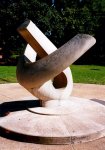 |
Chicago |
Illinois |
USA |
Equatorial Dial |
Dial 271 |
| ca 8' dia. Stone ca 7' high Two curved C shaped forms placed at perpendicular angles. |
| |
| |
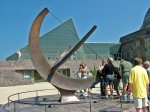 |
Chicago |
Illinois |
USA |
Equatorial Dial |
Dial 223 |
| Henry Moore Sundial Sculpture: 13 foot bronze equatorial dial built in 1980. Two bronze semicircles, one set inside and at right angles to the other, form the main elements. A slim rod runs from one end of the outer semicircle to the other end and its shadow on the inner semicircle below marks the time of day. EOT correction is provided. |
| |
| |
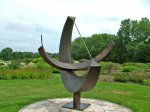 |
Chicago |
Illinois |
USA |
Equatorial Dial |
Dial 228 |
| Equatorial in bronze. 2 meters in diameter. Arabic hour numerals. Hour scale is subdivided into 5 minute intervals. |
| |
| |
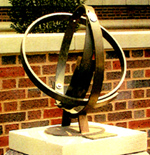 |
Cincinnati |
Ohio |
USA |
Armillary Sphere |
Dial 26 |
| This is an unusual armillary sphere without the standard gnomon rod, allowing the dial to be adjusted easily to tell civil time. As generally expected of an armillary or equatorial sundial, there is an equatorial time ring (16 inches in diameter) with engraved hourly time marks fastened to a meridian ring. But for this dial the equatorial and meridian ring assembly rotates on a polar axis. The dial functions as a Pilkington & Gibbs Heliochronometer: A small hole with lens where the equatorial and meridian rings meet allows a focused spot of sunlight to fall upon the opposite side of the rings where there is a plaque engraved with an analemma and associated monthly and day marks along the curve. This assembly is an analemmic alidade, allowing the user to align the spot of sun to an offset along the analemma curve of date that adjusting the sundial for the equation of time and longitude off time zone meridian. Civil time is read on the equatorial ring from a marker located on a fixed meridian. Knowing the month and approximate day, the dial can be read to the nearest minute. |
| |
| |
 |
Cincinnati |
Ohio |
USA |
Analemmatic Dial |
Dial 993 |
| This analemmatic sundial is laid out in brick. The walkway consists of an inlaid brass analemma surrounded by month indicators for where to stand etched in brick. The analemmatic ellipse is brass, etched with time marks every 15 minutes. Just to the inside and outside of the ellipse are the hours in standard and daylight savings time. Brass indicators are inlaid for the Bailey Points to show the of time and direction of sunrise and sunset. At the edge of the circular brick plaza are granite markers of the cardinal points. |
| |
| |
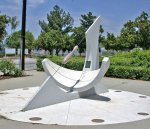 |
Claremont |
California |
USA |
Equatorial Dial |
Dial 505 |
| A 90 inch diameter spherical segment equatorial dial ten feet high of masonry construction with 3D fiberglass analemmic gnomon 40 inches long. Dial terrazzo face has hour, half-hour, quarter-hour and 5-minute marks with Roman hour numerals for PST. The 5-minute marks are one inch apart. Dial face includes analemma graphic with month dates; a plaque describes how to use the analemma graphic to select which side of the gnomon shadow to use to read time. Base perimeter has 12 ceramic plaques with Zodiacal signs.
Indicated time is accurate to one minute throughout the winter and to five minutes in summer. This is remarkable because the dial is located just outside a children's playground and children routinely climb on the dial and swing from the gnomon. An animation from digital images showing the gnomon shadow motion over the course of a full year is available.
Dedicated as the Ralph B. Larkin Memorial Sundial. Rev. Larkin was a retired missionary who taught science to children for 17 years in Claremont. Dr. Larkin's father was Edgar Lucien Larkin, Director of the Mt. Lowe Observatory above Los Angeles 1900-1924 using a 16-inch Alvan Clark refractor telescope, described by Alvan Clark as, "the finest telescope I ever made." Ralph Larkin often said, "I grew up with a telescope." The Mt. Lowe Observatory was destroyed in a windstorm in 1928 and the Alvan Clark refractor was moved to Ricard Observatory at the University of Santa Clara, California. |
| |
| |
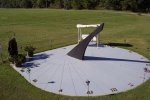 |
Claremore |
Oklahoma |
USA |
Horizontal Dial |
Dial 549 |
| A 24x36 foot all-concrete horizontal dial with marks to indicate summer solstice and equinox. Located on private property; contact owner Dan Wilson to arrange viewing. |
| |
| |
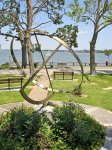 |
Clear Lake Shores |
Texas |
USA |
Armillary Sphere |
Dial 673 |
| An approximately four foot diameter ring equatorial dial of painted steel with Roman numeral hour marks and a long double-bar steel gnomon. Ring is sagging somewhat at base support, perhaps from being climbed upon. |
| |
| |
 |
Cleveland |
Ohio |
USA |
Horizontal Dial |
Dial 619 |
| A 7 foot diameter semicircular inclined horizontal dial of concrete with a bronze gnomon. Gnomon support features a cast representation of a nautilus shell. Each hour arc is marked with a geologic period within the "542 million year period" most animal life has evolved. |
| |
| |
|
Cleveland |
Ohio |
USA |
Horizontal Dial |
Dial 270 |
| Horizontal dial 50 ft in diameter. Bronze octagonal sundial with flaring flange decorated with the 12 signs of the zodiac. Dial rests on an octagonal stone pillar. |
| |
| |
|
Cleveland |
Ohio |
USA |
Armillary Sphere |
Dial 285 |
| In 2014, Cleveland Botanical Garden joined forces with The Holden Arboretum to become Holden Forests and Gardens. The dial is a 37 inch diameter armillary. Composed of four iron rings bisected by an arrow. Mounted atop an upright cylinder. Gift of Lucile Teeter Kissach. Restored 1993. |
| |
| |
|
Cleveland |
Ohio |
USA |
Horizontal Dial |
Dial 405 |
| A ground level horizontal dial 14 feet in diameter, with gnomon 5 ft 3 inches high. The dial is made of concrete, brick, and granite. |
| |
| |
 |
Clifton Village |
Ohio |
USA |
Vertical Dial |
Dial 610 |
| A 35 x 23 inch vertical acrylic painted wood dial. Dial face includes longitude-corrected hour lines with Roman numerals, noon analemma, and equinox and zodiacal declination arcs. The dial is designed for a declination of 1° 18' West of South. Dial nomenclature includes location, declination and time zone offset. |
| |
| |
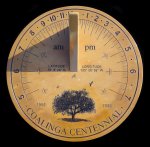 |
Coalinga |
California |
USA |
Horizontal Dial |
Dial 764 |
| A 26 inch diameter hand-carved, lacquer-coated beige sandstone horizontal dial set flush in a massive cast concrete pedestal. Dial has a thick stone gnomon, hour, half-hour and quarter-hour lines with Arabic ST hour numerals corrected for longitude. Face is marked with symbols showing sunrise and sunset times on solstices and equinoxes and with location coordinates. Dial face includes a hand carved graphic of a Valley Oak tree, symbolic of the San Joaquin Valley dial location.
The dial is embedded in a three foot cube cast concrete pedestal bearing a bas relief image of a horned toad, mascot of the Coalinga High School and the city centennial dates 1906 - 2006. |
| |
| |
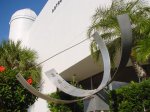 |
Cocoa |
Florida |
USA |
Equatorial Dial |
Dial 471 |
| This is a simple equatorial dial 58 inches wide and 49.5 inches high. Because of the low latitude, the 6 inch wide equatorial band has Roman hour markings only from 7am to 5 pm. The gnomon is a thin, unadorned rod. The dial base is a square box with canted top to the Florida latitude, supporting the equatorial cross members. |
| |
| |
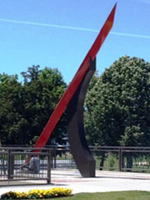 |
Coeur d'Alene |
Idaho |
USA |
Horizontal Dial |
Dial 812 |
| In 2013 the city of Coeur d'Alene began a $20M renovation of downtown McEuen Park, a 22-acre expanse, to include a large sundial. But shortly after the renovation started, the city commissioners were told the $51,000 that was to be spent on the sundial was instead to be used to install heavier electrical infrastructure for support of major park events. Fortunately by the end of 2013, the City Staff announced that the sundial was added back to the park's plan, made possible by a $50,000 donation from Parkwood Business Properties. |
| |
| |
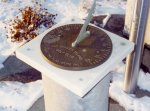 |
Cohoes |
New York |
USA |
Horizontal Dial |
Dial 239 |
| 12' Bronze 10' Metal dial mounted on marble(?) square atop column. Roman numerals 5AM-7PM. 'Van Schaick Island Golf Club' on dial face above inscription. 'In memory of/ John F. Gaucas/ Who Served as Golf Professional at the/ Van Schaick Island Country Club/ 1944 to 1974' on small granite marker near base of dial. |
| |
| |
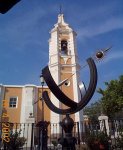 |
Colima |
Colima |
Mexico |
Equatorial Dial |
Dial 477 |
| A bright bronze equatorial sundial with a stainless steel equatorial band. The gnomon has an analemma for the correction of time and a colorful sunburst near the northern end of the rod. |
| |
| |
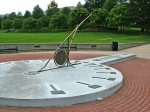 |
College Park |
Maryland |
USA |
Horizontal Dial |
Dial 260 |
| Very large horizontal dial 25 foot in diameter. Concrete dial with bronze gnomon 6' 6" high at tip. Has hour markers on raised circular slab. Metal disc with university seal in center of pierced gnomon. Adjacent graph provided correction for both EOT and mean/standard time differences. Due north or gnomon are shadow markers for date of year. Relocated May 1991 to present site. |
| |
| |
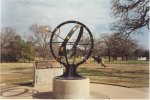 |
College Station |
Texas |
USA |
Armillary Sphere |
Dial 134 |
| Called the Texas A&M Armillary Sphere, this sundial is 60 inches in diameter. Made of wrought iron, it has one large vertical ring representing the meridian at College Station. Attached to the inside of this ring is a wide band representing the celestial equator. The outside of this band is decorated with gold signs of the zodiac. On the inside are gold roman numerals for each hour. A rod with gold tip and ornate fan is the gnomon. A metal plaque mounted nearby gives a description of the dial and EoT corrections. Dial donated by Searcy Bracewell, class of '38. Built by Kenneth Lynch & Sons, Wilton, CT. Dial sits atop a concrete cylinder, 2 foot high, 3 foot diameter. |
| |
| |
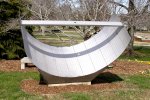 |
Collegedale |
Tennessee |
USA |
Cylindrical Dial |
Dial 113 |
| ca 6'cylindrical segment, about 3' high Stainless steel Large equatorial, corrected for longitude. Nodus is a hole on a horizontal gnomon rod running E/W across face. Can compensate for DST by shifting dial via bolts/slots in base. Solstice lines run along top/bottom edge of cylinder. Built by Fabricators Inc., Chattanooga TN |
| |
| |
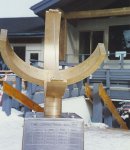 |
Collingwood |
Ontario |
Canada |
Equatorial Dial |
Dial 333 |
| The 12 inch equatorial dial is made of brass with a thin wire gnomon along the polar axis. The dial is mounted on a stainless steel cube with an engraved Equation of Time correction table on the four sides of the cube. The sundial is dedicated to those age 80 an older who have skied at the Oster Bluff Ski Resort. They remind us that the days of enjoyment continue in the winter of our lives, we celebrate the wisdom and social grace they have shared with us as well as their devotion to the sport of skiing. January 1996 |
| |
| |
 |
Collinsville |
Illinois |
USA |
Sun Alignment |
Dial 94 |
| At the Cahokia Mounds is a woodhenge discovered in the early 1960's during excavations and has been reconstructed. There are a series of wood posts in multiple circles that indicate various solar events such as the solstices, equinoxes, and what are thought to be special festival days related to the agricultural cycle of the region. Critical posts also align with the mounds of the site on certain dates. The outer of 3 circles of posts has a diameter of 410 feet with 48 equidistant posts. Each post is about 20 feet high. Equinox and solstice sunrise observations are held at the site on the Sunday morning closest to the event. |
| |
| |
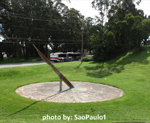 |
Colma |
California |
USA |
Horizontal Dial |
Dial 21 |
| This large ground-level horizontal dial is 40 ft. diameter. Formerly a floral dial with a cypress tree as gnomon and hour lines crafted out of plants such as santilina shrubs. During the 1960's the dial was changed to concrete and aluminum. Now approaching 2020, the concrete dial has a brick surround. Time is marked by large Roman numerals and hour lines in an interior chapter ring. The gnomon is a supported beam with a graceful shaped tip. It may be aluminum, but shows signs of weathering. |
| |
| |
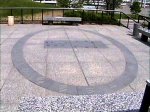 |
Colorado Springs |
Colorado |
USA |
Analemmatic Dial |
Dial 222 |
| Analemmatic dial in granite and bronze. 9ft x 12ft. Mottled granite block surface with number border of smooth granite blocks. Hour numbers are engraved in granite. Zodiac marker is brass, embedded in the granite face. As with most analemmatics, the dial is not corrected for longitude. Fortunately, the location is very close to the center of the time zone at 105 deg W. User stands on a central analemma at correct date and acts as the gnomon to cast a shadow that points to local solar time. The aspect ratio is not correct for the latitude and the positions of the solstice markers are slightly off. |
| |
| |
 |
Colorado Springs |
Colorado |
USA |
Vertical Dial |
Dial 499 |
| A vertical dial approximately one meter square, built into the wall of the 1907 Van Briggle Pottery building. This Memorial Pottery building was erected after Artus Van Briggle's death. The Van Briggle Pottery Company is now using the Midland Railway roundhouse at Hwy 24 and 21st. In addition to hour lines with Roman numerals, surrounding tiles have pictures of the zodiac. In 1994 Colorado College repaired the gnomon and added a metal equation of time plate. |
| |
| |
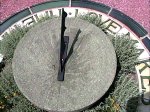 |
Colorado Springs |
Colorado |
USA |
Horizontal Dial |
Dial 500 |
| An old horizontal dial approx 60 cm diameter. From 1914-1967 was located at Marksheffel Garage, relocated to Monument Valley Park in 1967. The builder may have been van Briggle Pottery, but its history is more complex: The angles of the hour lines are consistent with a latitude of 43.9° (roughly) but the present location is 38.9°. A gnomon (probably not original) was cut for 34° lat, but has now been corrected. Likewise, the whole dial had to be rotated to true north, being off by some 47°. Hour lines have eroded, and those before 6am and after 6pm radiate from the wrong side of the gnomon. The city has spent a considerable amount of money cleaning up the area, removing the shrubs that blocked sunlight and building a nice brick wall with flowerbeds, so the area looks better, but the dial is worse than ever, with vandals bending the gnomon. |
| |
| |
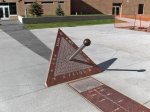 |
Colorado Springs |
Colorado |
USA |
Equatorial Dial |
Dial 570 |
| A 4 inch thick rose granite equatorial dial with a triangular dial face 60 inches on a side. A 70 inch long gnomon rod holds a 6 inch diameter spherical bronze nodus showing Earth as seen from space placed so that the Earth's axis is on the gnomon axis. The dial face shows solar noon and the dateline shows the date at solar noon and the equation of time. The granite plates are set 4 inches into concrete. |
| |
| |
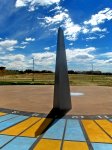 |
Colorado Springs |
Colorado |
USA |
Horizontal Dial |
Dial 604 |
| A monumental 120 foot diameter horizontal dial of painted concrete with a vertical 12 foot high concrete gnomon. Standard time and DST hour numerals are shown as are solstice and equinox lines. Dial face includes two 6 foot diameter inlaid mosaic maps of the Western and Eastern Hemispheres. The gnomon is a truncated three-sided equilateral pyramid that inclines to the north so that the northern corner is vertical. Two bronze plaques give instructions for reading and equation of time correction. Seen from above, the overall design incorporates a Yin Yang symbol appropriate for this elementary school specializing in teaching Chinese language and culture. |
| |
| |
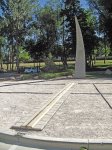 |
Colorado Springs |
Colorado |
USA |
Obelisk or Vertical Gnomon |
Dial 696 |
| A point-in-space or nodus dial with a 65 foot diameter dial face with seasonal markers extending nearly 150 foot wide due to uneven terrain. Time and date are indicated by the shadow of the tip of the 15 foot high curved gnomon. The dial is made of concrete, steel angle, cast iron and Breeze Stone, a compacted crushed stone. Roman hour numerals are cast iron, cast by students at The Colorado Springs School. The dial was designed and built by students, alumni and faculty of the school over a five year period. Provision is made for 60 stone date markers, set to indicate dates of significance to the school calendar. |
| |
| |
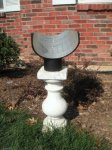 |
Columbia |
Missouri |
USA |
Cylindrical Dial |
Dial 496 |
| A cylindrical dial 10 inches in diameter constructed of photoengraved aluminum. The elegant dial plate shows each hour line as a full analemma and lines for Central Standard and Central Daylight Time. Accompanied by seasonal lines of solstice, equinox, monthly lines and other dates during the year. Back and base of dial are constructed of PVC. |
| |
| |
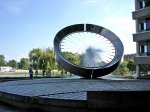 |
Columbus |
Ohio |
USA |
Sculpture/Artwork |
Dial 357 |
| "Hora Novem" An unusual 'solar calendar water sculpture' incorporating water jets which converge at center of a 17ft equatorial ring. |
| |
| |
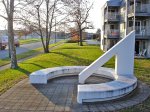 |
Columbus |
Indiana |
USA |
Horizontal Dial |
Dial 674 |
| A 10 foot diameter horizontal dial of concrete, stainless steel and brick. The gnomon is a massive concrete structure and the Arabic hour markers are inset in the concrete dial face, which serves as a bench. |
| |
| |
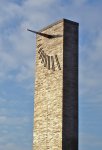 |
Columbus |
Indiana |
USA |
Vertical Dial |
Dial 675 |
| An approximately 10 x12 foot brick and stainless steel south-facing dial atop a 50 foot tower. This resembles an actual vertical dial but has a horizontal gnomon rather than a polar-pointing gnomon. The hour lines verify against ZW2000 software calculated angles for a due south dial but are non-functional with a horizontal gnomon. Dial face includes hour lines for 6 AM to 2 PM but no numerals. It's more sculpture than sundial. |
| |
| |
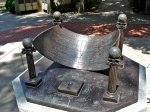 |
Columbus |
Ohio |
USA |
Cylindrical Dial |
Dial 681 |
| A cast bronze equatorial dial with inscribed analemma EOT figures on each hour line. Equatorial ring is a spherical segment. Arabic numerals mark Standard Time. Gnomon is missing. Dial sits atop a fluted Roman column on square base. |
| |
| |
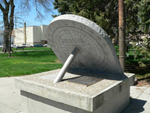 |
Columbus |
Nebraska |
USA |
Equatorial Dial |
Dial 938 |
| This monumental equatorial dial is in the style of an Erickson dial with 6-inch polar gnomon and granite dial plate about 10-inches thick and 4 feet in diameter. Summer hours (between the spring equinox and continuing until the fall equinox) are seen on the north face of the dial while winter hours (fall equinox and continuing until the spring equinox) are seen on the south face of the dial. Hours are delineated into quarter hours with hours marked in Arabic numbers. The chapter ring of hours divide the entire 24 hours of the day for artistic purposes. The dial sits on a square 5-foot concrete dais that holds a time capsule from the dial's dedication in 1986 that is to be opened 50 years hence in 2036. A bronze plaque on the dais explains the dial and the time capsule. |
| |
| |
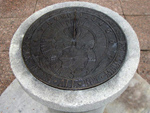 |
Columbus |
Ohio |
USA |
Horizontal Dial |
Dial 946 |
| This brass dial is a replica of the sundial installed at Mt. Vernon. It is about 12 inches in diameter with an offset eight point compass rose. The chapter ring has hour marks from 5am to 7pm in Arabic numerals. Hours are divided into quarter hours. Unfortunately the gnomon is broken off leaving only the lower third. |
| |
| |
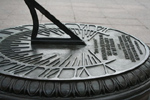 |
Columbus |
Ohio |
USA |
Horizontal Dial |
Dial 947 |
| This bronze dial is about 18 inches in diameter, with hours marked from 5am to 7pm in Roman numerals. Time is marked in quarter hours. Around the edge of the dial are ornate ovals that lap to the side. The gnomon is a simple open triangle. |
| |
| |
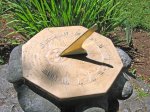 |
Colwood |
British Columbia |
Canada |
Horizontal Dial |
Dial 656 |
| A 12 inch octagonal stone horizontal dial with Roman hour numerals. Dial face depicts sun rays radiating from a central Beau Soleil to the hour numerals and outer time scale, which displays 5 minute graduations.
This historic dial dates from the original Pendray House on the Havenwood, built in 1928. The dial was in poor condition and the gnomon was missing. In July, 2009, NASS member Roger Bailey cleaned the dial, highlighted the markings and fabricated and installed a new brass gnomon.
The property is now Essencia at Esquimalt Lagoon, a private resort community but with public access for community activities. A stone path and arch lead to the dial, nearly overshadowed by a large tulip tree. |
| |
| |
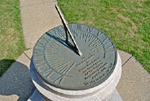 |
Concord |
New Hampshire |
USA |
Horizontal Dial |
Dial 300 |
| A 16 inch diameter cast bronze horizontal dial with 7 inch high cast and machined bronze gnomon. Dial face shows hour, half-hour and quarter-hour lines and Roman hour numerals 5 AM to 7 PM. The hour lines are corrected for longitude but no EOT correction is shown. |
| |
| |
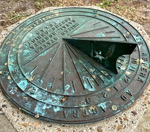 |
Corpus Christi |
Texas |
USA |
Horizontal Dial |
Dial 1083 |
| Farenholt sundial for U.S. Naval Hospital Corpus Christi Texas. This cast bronze dial was designed and commissioned by RADM Farenholt for U.S. Naval Hospitals at bases where he was commanding officer, visited, or had special meaning to him. The dial is 18 inches (46cm) in diameter. The outer chapter ring has the motto, followed by a chapter ring with Arabic hours 6am to 6pm, raised hour lines that radiate from near the foot of the gnomon and short half-hour lines. The gnomon has graceful curves and a star cut-out in the center. Below the gnomon is the naval command name, followed by the commissioning date in the southern portion of the hours chapter ring. |
| |
| |
 |
Corregidora |
Queretaro |
Mexico |
Gnomonic or Projection Dial |
Dial 768 |
| A projection (or, "negative") dial using the south-facing wall and floor of the "Cosmic Room" of a "casa de campo" private cottage. The tile roof over this room contains several skylights with slits for projecting a beam of sunlight onto the wall and one skylight with a small hole to project a dot of sunlight onto the room floor. |
| |
| |
 |
Council Bluffs |
Iowa |
USA |
Obelisk or Vertical Gnomon |
Dial 479 |
| Vertical gnomon casting its shadow onto a plaza in front of the city library. Modernistic design.
This dial has been scheduled for removal as of October, 2010 due to cracking and to make more green space. |
| |
| |
 |
Cove |
Oregon |
USA |
Equatorial Dial |
Dial 141 |
| An unusual sun sculpture 5 foot tall and approximately 20 inches in width and depth. Has hour and minute markings arranged on horizontal members. A 1/4 inch steel rod functions as the gnomon. The dial is set to read Pacific Daylight Solar Time, with a stated accuracy of 15 seconds of time. |
| |
| |
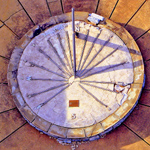 |
Cranford |
New Jersey |
USA |
Horizontal Dial |
Dial 797 |
| A 15 foot diameter horizontal dial with 5 foot high welded stainless steel plate gnomon. The dial face is elevated 18 inches by a white marble-faced platform above a 50 foot diameter concrete plaza that includes inset stainless steel hour line extensions. The dial face is rimmed with Bluestone and has elevated stainless steel hour lines for 4 am to 8 pm and elevated three inch stainless steel Arabic hour numerals. Cardinal directions are marked with elevated 6 inch stainless steel letters. |
| |
| |
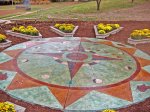 |
Crestwood |
Missouri |
USA |
Analemmatic Dial |
Dial 526 |
| This is a colorful analemmatic sundial 18 feet 6 inches overall diameter built of colored concrete. It is located on the grounds of a private elementary school in an area designated as a Sundial Garden. The sundial is surrounded by elevated flower planter boxes. The E-W markers are 10 feet apart and the date line is marked. The dial face shows the cardinal directions and phases of the moon. Viewing can be arranged by contacting Long Elementary School M-F 8:30 AM-3:15 PM. |
| |
| |
 |
Croton-on-Hudson |
New York |
USA |
Horizontal Dial |
Dial 769 |
| A 13-1/2 foot tall monumental horizontal dial memorial to the victims and responders of the 9/11/2001 World Trade Center terrorist attack. The memorial sundial gnomon is created from an 11000-pound, 14-foot long twisted steel beam once part of the North Tower of the World Trade Center. The gnomon is held at an angle of 41 deg 12 minutes by a 16-ton boulder with inset channel to cradle the twisted steel. |
| |
| |
|
Cuencame |
Durango |
Mexico |
Vertical Dial |
Dial 489 |
| This vertical dial is 2m tall by 1.2 m wide and sits atop a quarried column nearly 7 m high. The gnomon on each face is approximately 60 cm long, and 16-19 mm in diameter. Each face has Roman numerals to indicate apparent solar time from 6am to 6pm. Alpha and Omega Greek letters. A carved cross at the twelve hour line. Inscribed "1904" |
| |
| |
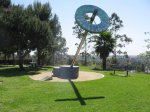 |
Culver City |
California |
USA |
Equatorial Dial |
Dial 536 |
| Located near the edge of a hill in Culver Park, this dial commands a fine view of the surrounding communities. The equatorial dial face is a six foot diameter, six inch thick brass ring supported by a 24 foot long steel gnomon six inches in diameter. The gnomon is anchored in a concrete oval-shaped base covered with tile and mosaics. The base and three surrounding water-drop shape ovals are inscribed with the word "Time" in the 12 languages spoken in Culver City. Ballona Creek, visible from the sundial, once provided transportation, food and recreation for a thriving native American population and later for Spanish-origin ranch owners. The dial north face has the 1:00 hour line at the bottom for Daylight Savings Time while the south face has the 12:00 hour line at the bottom for standard time. A bronze plaque states time is read from the center of the gnomon shadow and briefly discusses the equation of time. The dial is not longitude corrected and indicates local apparent time. |
| |